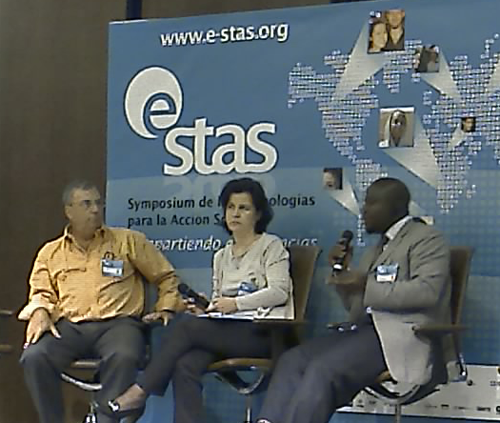e-STAS is a Symposium about the Technologies for the Social Action, with an international and multi-stakeholder nature, where all the agents implicated in the development and implementation of the ICT (NGO’s, Local authorities, Universities, Companies and Media) are appointed in an aim to promote, foster and adapt the use of the ICT for the social action.
Here come my notes for session II. (notes at random, grouped by speaker, but not necessarily in chronological order)
 Left to right: Daniel Pimienta, Stéphanie Lucien-Brun, Kafui Amenu Prebbie
Left to right: Daniel Pimienta, Stéphanie Lucien-Brun, Kafui Amenu Prebbie
ICTs can be very strong barriers towards rights expression if are not properly made accessible for everyone.
We should not talk about access, but about uses, strictly related with capacity. How technologies are appropriated and how people and communities are empowered. And how do you make sense of these technologies for emancipatory purposes, for community building, to engage people in the conversation and in participation.
Daniel Pimienta, Funredes
Participation is the key.
He explains a couple of interesting stories about open access and open science.
We should avoid strengthening the manufacturers (de facto) monopolies by training people not in capacities but in specific applications.
Digital literacy should be given way more importance than actually is.
Intellectual Property Rights need to be reconsidered (definition, application, etc.), as they are, in their actual state, a clear barrier for both the development of the Information Society and development in general.
The role of the Third Sector should not be connectivity, but appropriation.
How can the Digital Divide can be closed by using low cost technologies? The limiting factor of access is cost.
Then comes the right use of technology, and how to teach the best use of it.
Open Hardware Initiative, Merakis.
e-Stas 2008, Symposium on Technologies for Social Action (2008)
e-STAS is a Symposium about the Technologies for the Social Action, with an international and multi-stakeholder nature, where all the agents implicated in the development and implementation of the ICT (NGO’s, Local authorities, Universities, Companies and Media) are appointed in an aim to promote, foster and adapt the use of the ICT for the social action.
Here come my notes for session I.
Raul Zambrano, UNDP
ICTs, Digital Divide and Social Inclusion
Four stages of ICT Development
- connectivity, get people connected
- content and have people have capacities to deal with it
- services
- participation, Web 2.0
Digital divide
- Within countries
- Among countries
- Within and among countries
The difference between the digital divide in developed countries and developing ones is that in developing ones is but another manifestation of other divides — this is not necessarily this way in developed countries.
How can technology bride social divides, not technological divides?
Divides: differences attributed to knowledge, and differences dues to more physical and human capital.
Both the speed of adoption and the speed of diffusion of technologies are have very different paths in developed and developing countries [So, it’s not just that leapfrogging can be made possible (adoption), but it has to be actually fostered (diffusion). But, part of fostering diffusion to achieve quicker and broader adoption is about giving the population what they need and/or are asking for].
Thus, in the policy cycle (social gaps, awareness raising, citizen participation, agenda setting, policy design, development focused, implementation, evaluation/assessment, reduction of social gaps, new emerging issues), these population needs must be taken into account when designing public policies.
In this policy cycle, networking is crucial to gather all sensibilities and ensure that participation does take place. If there is not citizen participation, public policies are likely to be government’s or lobbies’ interests biased.
All in all, it’s about empowerment.
Comments, questions
I ask whether it’s better push (public led) or pull (private sector led) strategies.
Raul Zambrano answers in the framework of developing countries. In these developing countries, the Estate is to foster and create aggregated demand, it is the main purchaser, investor and installer of ICTs (infrastructures, services, etc.).
On the other hand, it is true that there is a latent demand from the citizenry, and there already is a manifested need for ICTs.
About the private sector, the problem in developing countries is that the private sector might not have resources enough to set up pull strategies. Or maybe they could, but it still makes poor sense for them when looking at the Return of Investment. This is especially true with developed countries firms trying to get established in developing countries, though local enterprises might not think (and behave) alike, and find it’s huge benefits what elsewhere might not even make it worth it trying.
So, put short, in developing countries what seems to be working is a centralized model but progressively decentralized [as the subsidiarity principle in the European Union, I’d dare add].
Do we need to keep on working on access (if everyone already has a cellular)?
Yes, definitely, but not as an independent variable but as a dependent one [this is one of the cleverest statements I’ve heard in months about the digital divide].
Paco Ortiz (AHCIET) intervenes in this issue: incumbent telecomms normally pay a ratio of their profits to governments so the latter can help solve the last mile issue. The problem being that once these governments have cash to do so, the sometimes shift the funds to other priorities — no critique intended: these priorities can be Education or Health. Thus, legitimate or not, the result is that universal access is never achieved, but not at the private sector’s fault.
One person from the audience harshly attacks governments for their corruption, which invalidates them to foster any kind of policy or to get any kind of funding from whom ever.
Raul Zambrano states that it is precisely transparency and accountability one of the main goals of ICTs in the sphere of the government.
e-Stas 2008, Symposium on Technologies for Social Action (2008)


